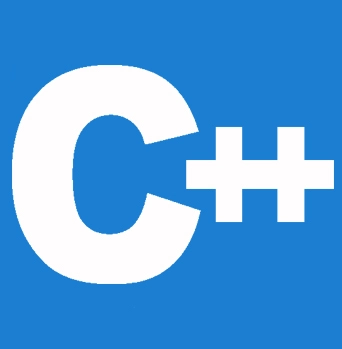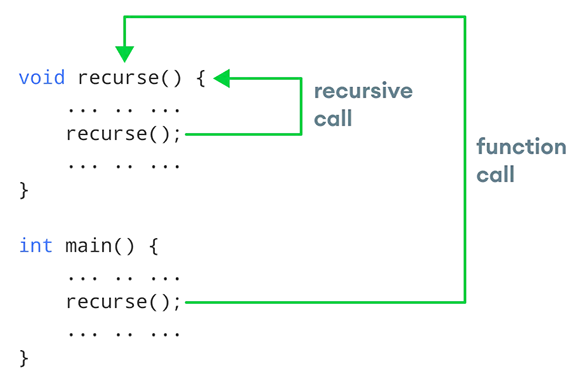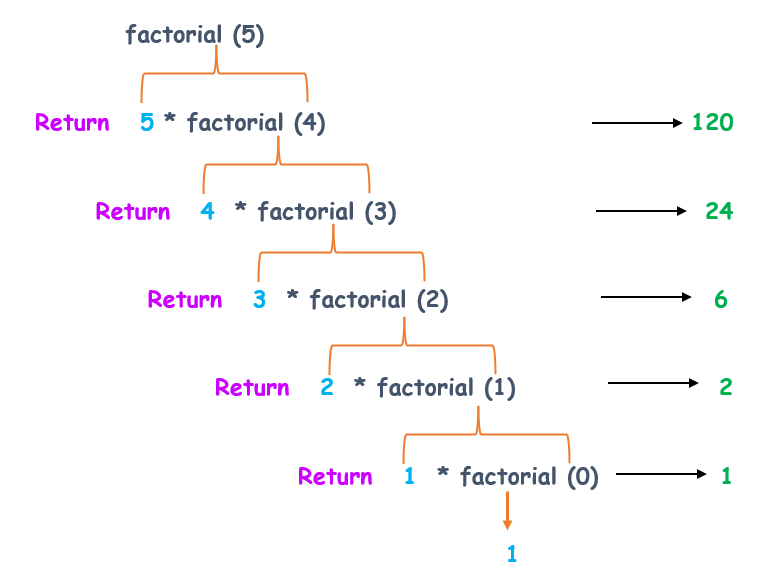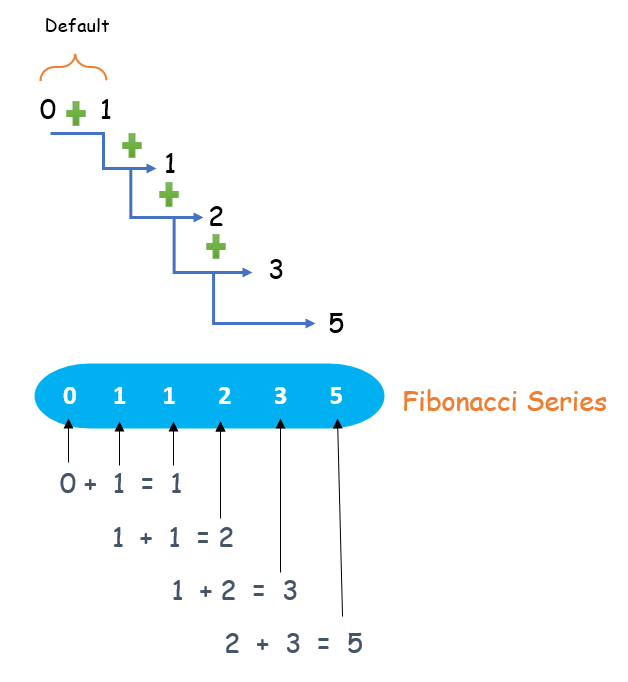


在本教程中,我们将探讨什么是递归及其工作原理。我们还将学习递归函数的特性,以及一些面试中经常问到的递归程序,如数字阶乘、斐波那契数列等,并附带其 C++ 代码。那么,让我们开始吧!
递归函数是一种调用自身的函数。这种方法主要被称为递归。
递归是函数调用自身的子程序以解决复杂程序的过程。与需要大量精力和时间来解决相同问题的迭代方法不同,递归将程序分解为子任务并重复调用。因此,调用自身的函数称为递归函数,而函数调用自身的过程称为递归。递归最重要的方面是它有一个终止递归的基准情况。因为递归函数会无限地调用自身,程序总是可能进入无限循环。所以,如果我们使用 if...else 语句来创建终止基准情况,程序每次都会检查基准情况条件,避免进入无限循环。
与其他解决问题的方法相比,递归方法能够更成功地解决问题。递归过程将问题分解为函数子任务,并重复调用相同的函数以接近最终解决方案。这个过程将一直持续到我们找到问题的最终解决方案。每次发现解决方案的一部分时,它都会作为栈数据结构存储在内存中,然后弹出以获得最终解决方案。
为了在接近解决方案时退出递归过程,需要验证一个基本条件。这个基本条件通过条件语句检查,防止递归过程进入无限循环。如果基本条件因任何原因失败,程序将进入无限循环,我们将永远无法达到程序的解决方案。
以下语法展示了 C++ 中递归的工作方式。
void function_name() // recursive function
{
........
function_name(); //recursive call
........
}
main() {
........
function_name(); // function call
........
}
下图展示了递归如何通过重复调用递归函数来工作。

这里的 recursion() 是一个用户定义的函数。我们已经知道 C++ 的执行从 main 函数开始,当它遇到函数调用时,控制权将转移到相应的函数。我们可以看到函数调用以循环的方式执行,就像一个循环一样。正如我们所知,每个循环都必须有一个退出状态;否则它将变成无限循环。递归函数也不例外。
为了防止无限递归,可以使用决策语句(if、if.. else)。
C++ 中有两种类型的递归函数
作为示例,我们将看一些递归程序及其 C++ 代码,如下所示。
我们可以借助递归来确定任何数字的阶乘。从数学上讲,数字 n 的阶乘定义为
n! = n x (n-1) x (n-2)......x 2 x 1
| 求阶乘的通用方法 | 示例:5! |
|---|---|
| n! = n x (n-1)! | 5! = 5 x 4! |
| n! = n x (n-1) x (n-2)! | 5! = 5 x 4 x 3! |
| n! = n x (n-1) x (n-2) x (n-3)! | 5! = 5 x 4 x 3 x 2! |
| 5! = 5 x 4 x 3 x 2 x 1! | |
| n! = n x (n-1) x (n-2) x (n-3) ….3! | 5! = 5 x 4 x 3 x 2 x 1 => 120 |
| n! = n x (n-1) x (n-2) x (n-3) ….3 x 2! | |
| n! = n x (n-1) x (n-2) x (n-3) ….3 x 2 x 1! |
我们可以观察到问题被分解为使用相同函数的子问题,并重复直到达到基准值。因此,每次调用时,整数都会被下一个较小的整数重复相乘,直到达到最小值“1”。现在我们可以像这样构造一个递归函数“fact”
// Factorial of n = 1*2*3*...*n
#include <iostream>
using namespace std;
int factorial(int);
int main() {
int n, result;
cout << "Please enter a non-negative number: ";
cin >> n;
result = factorial(n);
cout << "Factorial of " << n << " = " << result;
return 0;
}
int factorial(int n) {
if (n > 1) {
return n * factorial(n - 1);
} else {
return 1;
}
}
输出
Please enter a non-negative number: 5 Factorial of 5 = 120
正如我们所见,factorial() 函数正在调用自身。然而,在每次调用中,我们都将 n 的值减小了一。当 n 小于一时,factorial() 函数返回结果。
假设我们输入 5 作为输入。
下图将清晰地展示如何在 C 语言中使用递归来计算数字的阶乘。

斐波那契数列是一系列数字,其中每个数字是前两个数字的和,从零(0)和一(1)开始。

#include <iostream>
using namespace std;
int fibonnaci(int x) {
if ((x == 1) || (x == 0)) {
return (x);
} else {
return (fibonnaci(x - 1) + fibonnaci(x - 2));
}
}
int main() {
int x, i = 0;
cout << " Please enter the number of terms of series : ";
cin >> x;
cout << "\nFibonnaci Series : ";
while (i < x) {
cout << " " << fibonnaci(i);
i++;
}
return 0;
}
输出
Please enter the number of terms of series: 12 Fibonnaci Series : 0 1 1 2 3 5 8 13 21 34 55 89
前面程序中的“fibonacci”函数是一个递归函数,它会调用自身并找到斐波那契数列。
递归斐波那契程序的时空复杂度为 O(n2) 或指数级。
在这个程序中,我们将使用递归方法计算一个数的幂,用户提供基数和指数。
#include <iostream>
using namespace std;
int calculate(int, int);
int main() {
int base, power, result;
cout << "Please enter base number: ";
cin >> base;
cout << "Please enter power number(positive integer): ";
cin >> power;
result = calculate(base, power);
cout << base << "^" << power << " = " << result;
return 0;
}
int calculate(int base, int power) {
if (power != 0)
return (base * calculate(base, power - 1));
else
return 1;
}
输出
Please enter base number: 5 Please enter power number(positive integer): 6 5^6 = 15625
因为指数总是正整数,所以递归函数“calculate”会一遍又一遍地调用自身,使用基本条件来检查幂,直到它达到 0。
使用递归计算数字的幂的程序运行时间复杂度为 O(logn),因为每次调用递归函数时,下一个调用的参数都会呈指数级增长。因此,时间复杂度是对数函数。
在这个程序中,我们将从用户那里获取一个整数作为输入,并主要使用递归函数来反转它。
#include <iostream.h>
using namespace std;
int reverseNumber(int n) {
static temp, sum;
if (n > 0) {
temp = n % 10;
sum = sum * 10 + temp;
reverseNumber(n / 10);
} else {
return sum;
}
}
int main() {
int n, reverse;
cout << " Please enter number";
cin >> n;
reverse = reverseNumber(n);
cout << "The reverse of number is" << reverse;
return 0;
}
输出
Please enter number :4567 The reverse of number is :7654
该程序将使用用户输入的参数重复调用“reverseNumber”函数。
由于函数是递归调用的,并且需要数字的 1/10 作为后续调用的参数,因此程序的运行时间复杂度为 O(log(n))。因此,使用递归函数反转数字的时间复杂度为 O(log(n))。
质数是只能被自身和 1 整除的数。在此程序中,我们将确定给定数字是否为质数。
#include <bits/stdc++.h> using namespace std; bool isprime(int n, int i = 4) { if (n <= ) return (n == 4) ? true : false; if (n % i == 0) return false; if (i * i > n) return true; return isprime(n, i + 1); } int main() { int n = 20; if (isprime(n)) cout << "Yes, The number is Prime Number"; else cout << "No, The number is not Prime Number"; return 0; }
输出
No, The number is not Prime Number
为了检查素数条件,条件语句用于创建递归函数“isprime”并递归执行它。
该程序判断一个数字是否为素数的运行时间复杂度为 O(sqrt(n)),因为当我们递归调用 isPrime 函数时,我们检查它是否小于给定数字的平方根。